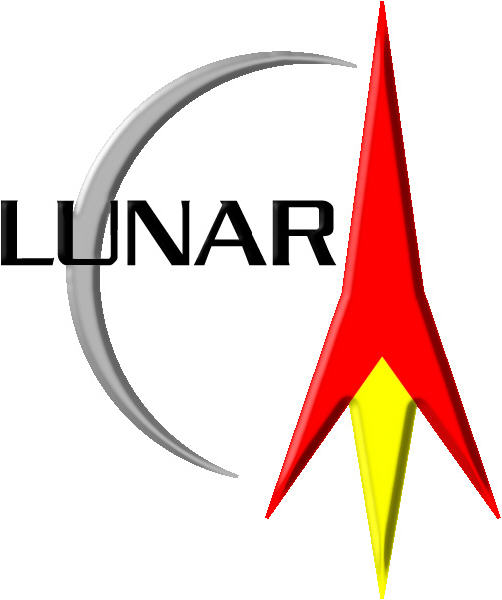 LUNAR’clips
2001
Volume 8, Number 4
LUNAR’clips
2001
Volume 8, Number 4 LUNAR’clips
2001
Volume 8, Number 4
LUNAR’clips
2001
Volume 8, Number 4
Livermore Unit of the National Association of Rocketry July/December 2001
Copyright © 2001 by LUNAR, All rights reserved.
Chuck McConaghy, Lunar # 359
John McConaghy, Lunar # 360
I don’t know whether I like the desert for the spectacular scenery or the spectacular rocket launches. In any case I was glad when the family camping trip my sister-in-law had planned for the July 20-21 weekend didn’t come together. At the last minute, my son John and I decided to pull our tent trailer down to LDRS 20 and have our own camp out. This is the third LDRS we have attended (previously attended LDRS 14 & 16), and I can say I think it was the largest. The parking area on Saturday had cars stacked everywhere. Not only were there a large number of rocketeers, but also I think a number of spectators had come out just to see what was going on. The launch site on the Lucerne dry lake is relatively close to Los Angeles. It is just over the mountains from San Bernadino. I have never been there before and was surprised to find that, although in the desert, it has sizable population in close proximity. The early mornings were just beautiful and also were the best time to launch. The first rockets were launched every day around 6 a.m., which was good, because the high afternoon winds and blowing sand arrived like clockwork and shut things down by about 2:00 p.m. everyday.
LDRS means "Large and Dangerous Rocket Ships" (it took me several years to learn the meaning of the acronym). The dangerous part cannot be over-emphasized. There was a large V2, 1/3 scale I think, whose owners had invested a lot of time and money. I heard the owner describing the project to a TV interviewer on Friday. He said it was built over a period from January to about May and was constructed almost entirely of material from Home Depot. It flew on Saturday morning. The V2 took off fine on its’ M engine but it seemed underpowered for its’ weight and began to turn directly toward the parking area and crowd. At this point, the chutes attempted to deploy, but the nose cone ripped off and the rest of the rocket came horizontally over the parking area, not far from us, and crashed into the desert behind the cars. Then hundreds of people (ok we were two of them) ran to the remains of the crashed V2. It was a scene out of a movie where the alien spacecraft crashes. Civil Air Patrol cadets who were to keep spectators at a safe distance surrounded the crash site, which was a large crater with debris scattered everywhere. We watched the sad owner salvage the main chute, still in its deployment bag, and the fin section, which was sort of intact. I later read that the problem with the launch began when the launch rail partly ripped off the tower.
New M class hybrid engines were on several flights at LDRS. These engines make a distinctive sound that is quite impressive. One of the largest hybrid flights was an upscale version of a rocket from the movie Toy Story called "The Big One." This was an extremely large diameter rocket, which made a spectacular and successful flight on an M hybrid.
One of the nice things about LDRS is that many vendors are present. I spent some time learning about hybrid engines and got a complete tutorial on the Olsen flight computer from, none other than, Mr. Olsen himself. We also had a nice conversation with Ray R. Dunakin III, who had a recent article in HPR (Feb 2001). He has some rockets that take great pictures. His pictures for LDRS 20 can be found at:
On both Saturday and Sunday mornings, someone sang the Star Spangled Banner, and at the stanza "the rocket’s red glare" a rocket with the new redline reload was launched.
Over a three-day period, we personally launched four of our "fleet". This included our Phobos with an H97, our Aspire on a G-75, our glassed Mini-Mag on a J350, and our Eclipse on an I300. The lines were quite long and the fastest time between standing at the RSO table and picking up our recovered rocket was an hour…on a few of the launches it was over two hours. An interesting aspect of the recovery is that the range is never shut down. You just go out and get your rocket while they are still launching. The same is also true of loading your rocket on the rack. In theory, they are launching on the left range while you load on the right and vice versa. However, there were some middle racks and many launches from the really high power pads. We learned that the terms "cluster" and "multistage" really mean, "run for your lives." It was a little unnerving to be recovering a rocket and hear the PA system announce, "Heads up we have a multi-stage…cluster".
The ROC group that hosted LDRS was well organized and the LCO table had a huge slotted board labeled by rod size. As people were assigned pads, their flight card would be put in the appropriate slot. The other thing that was super-sized at LDRS is the length of the flight line. This line of pennants stretched from far off in the West to far into the East to keep the crowds out of the range.
We had a good time and enjoyed watching and mingling as much as launching.
Return to IndexAll content is the responsibility of LUNAR.
If you have comments or suggestions regarding these web pages,
please contact the 
Copyright © 1992 - 2025 LUNAR